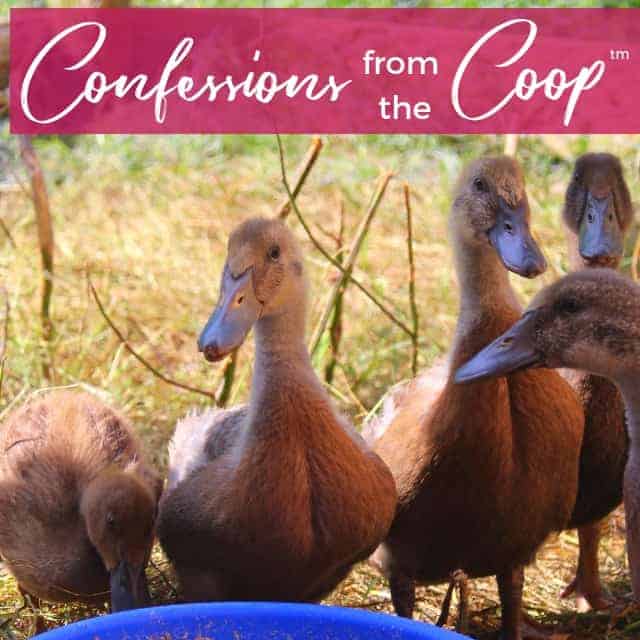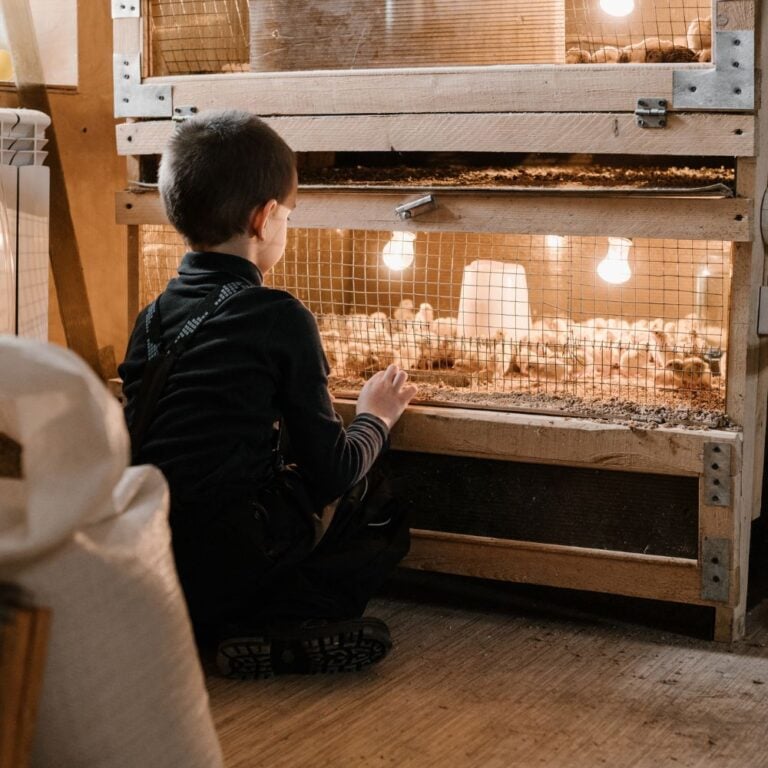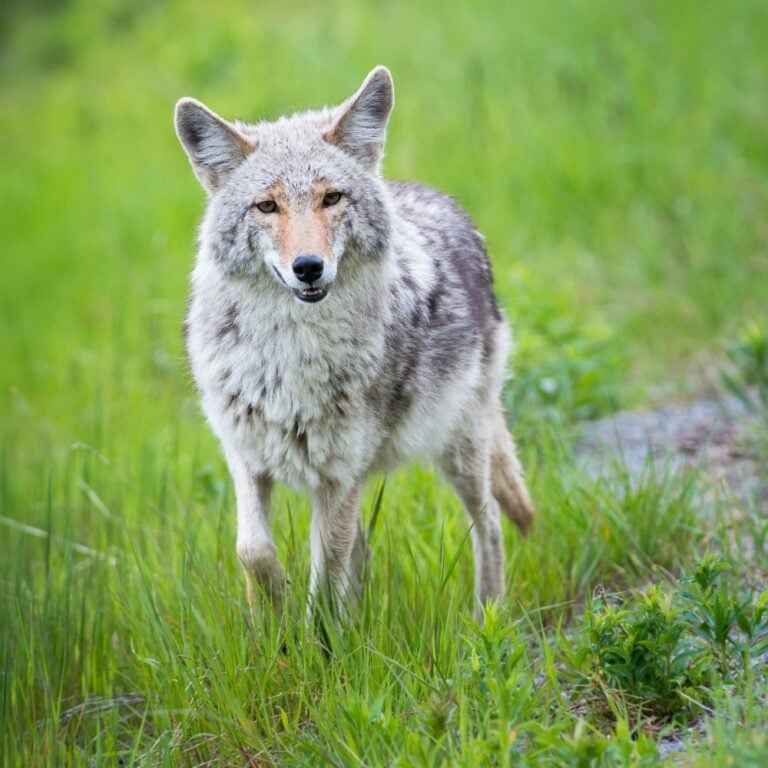Ameraucana chickens have beautiful eyes, multicolored feathers, and lay lovely blue eggs. But that’s not all this breed offers. Read more!
With the Ameraucana chickens large, expressive eyes and cartoon look, they could just be the inspiration you need to become a “crazy chicken person.” And there’s a whole lot more to this rare chicken than their eyes, multicolored feathers, and the lovely blue eggs they lay!
You should know upfront that this breed of chicken is easily confused with the Araucana chicken – especially since both breeds lay blue eggs. They also get confused with Easter Eggers because of some of their characteristics. You’ll see online that lots different types of chickens are sold as Ameraucana chickens, when they are NOT. We will cover that in this article so you can be an informed chicken shopper.
Now, let’s move in closer and inspect the Ameraucana chicken from head to toe.
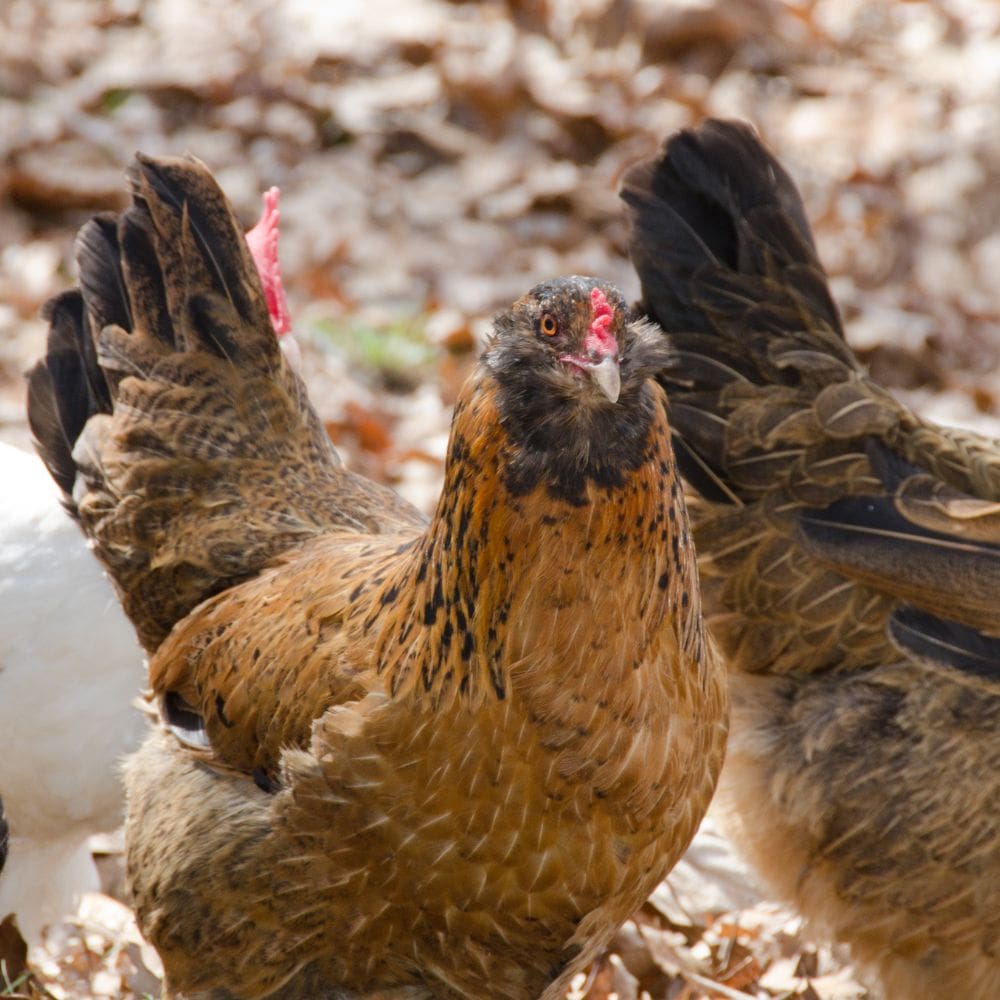
Table of Contents (Quickly Jump To Information)
Ameruacana History
For a little bit of storytelling, Ameraucana chickens originated in the United States.
Agricultural scientists created this breed, hoping to preserve the genetics of the South American, blue-egg laying Araucana chicken – but also to eliminate its lethal gene that can kill the chick while inside the shell. Eventually, the Pratt Experimental Farm in Pennsylvania got the right genes together sometime in the early 70’s.
And yes, the majority of breeds of chickens are not considered “true chicken breeds” by most people until the American Poultry Association (APA) says so, and eight varieties later it was finally recognized by APA and American Bantam Association (ABA) in the 1980s.
They are still considered a rare breed here in the United States, so they can be a bit harder to find a place to buy them.
About Ameraucana Chickens – Breed Characteristics & Personalities
What Do Ameraucana Chickens Look Like?
Ameraucana chickens have a beautiful curved beak, large eyes, and a red “pea” comb. This pea comb, together with the wattles and the round earlobes, should be red. This chicken breed also sports a few uncanny characteristics like having blue slate shanks and bottoms.
Ameraucana chickens also appear to have a “beard of feathers” and adorable muffs that sometimes almost cover their face. This makes them charming – giving you more reason to own and breed one, if the “chicken gods” would permit you to find Ameraucana chickens for sale.
Are Ameraucanas Cold Hardy?
Most chicken breeds are cold hardy, and Ameraucanas are no exception – ours have always done better in winter than summer. They also lay well during colder seasons.
Our Ameraucanas don’t really like going out in the snow, but because they have small pea combs and smaller wattles, they are resistant to frostbite on these areas.
Offering your flock extra treats during the colder months can lift their spirits and provide extra protein to help them endure the cold.
Can Ameraucana Chickens Fly?
Ameraucana chickens can fly short distances and enjoy the view from a tree branch. They’re smaller and lighter framed than other heavier chicken breeds (like buff orpingtons and brahmas, for example), so it’s easier for them to catch some air for lift off.
They won’t fly long distances or even leave your farm, though.
How Long Do Ameraucana Chickens Live?
While backyard Araucanas can live more than 10 years, the actual lifespan of your Ameraucana chick can vary greatly depending on its diet, genetics and exposure to predators.
Most pet chickens live between 5-6 years if they’re given a warm shelter and a high quality layer feed, clean chicken feeders and waterers, and are protected from fox, raccoons, and other predators.
Ameraucana Personalities
This breed can be misunderstood because there is a variety of Ameraucana chicken temperaments. Looks are deceiving for this breed.
A lot of breeders would testify that it is a friendly breed and easy to tame. They can be fun to watch when they start being curious and explore the backyard. Other folks love them, but do not consider then to be super friendly.
To give a piece of advice though, you might need to think twice about picking them up for a cuddle unless you take the time to handle them often. These mild chickens are also easily spooked when they are not used to having humans around and can be broody (and broody hens are usually not the friendliest).
In Ameraucana flocks, males are dominant. They protect hens when in they’re in trouble, but they can be aggressive too. It is a good practice to separate the males from females when they’re not breeding if the roosters are being difficult.
While they enjoy free-ranging and enjoying mother nature’s treat, this is a breed that doesn’t mind confinement. They can easily adjust and thrive cooped up, as long as their environment is set up to reduce stress. You can provide them treats and toys to keep them entertained so they don’t become angry birds.
What Is The Difference Between Easter Eggers and Araucana and Ameraucana Chickens?
Araucana vs Ameraucana vs Easter Egger are common subjects in forums and threads, but Ameraucana chickens have a few stand out characteristics that separate it from the other blue egg layers.
Easter eggers are hybrids, usually a mix between Ameraucana or Araucana chickens and a brown egg layer, such as a Rhode Island Red. They come from different breeds with one parent having the blue egg laying gene.
If closely compared the Easter Eggers, Ameraucanas will also have a well spread, full tail. Araucana chickens, on the other hand, are “rumpless.”
Unlike Ameraucana chickens, Easter Eggers don’t just lay blue eggs – they can lay brown, green, or even pink eggs – a veritable rainbow of egg colors.
Also, they do not breed true, so even if you breed 2 Easter Egger chickens together, there’s no telling what characteristics the offspring will have. No two Easter Eggers look exactly the same. Personally, I like this “grab bag” approach to breeding, it can have some surprising and offbeat results.
Help! This is Confusing!
This can be confusing, as you can see. But here’s a quick list in summary:
- Ameraucanas are NOT rumpless (if it’s rumpless, it’s an Araucana).
- Ameraucanas most usually have slate colored legs and feet (Araucana usually has yellow legs and feet, Easter Eggers can vary).
- Ameraucanas only lay blue eggs (Easter Eggers can lay several different colors of eggs. The tricky part is that Araucanas also only lay blue eggs, but remember – they are rumpless).
If your head is still in a tail spin, try this side by side comparison.
Ameraucana
- Has tail feathers
- No ear tufts
- Have beards
- Have muffs
- Breeds true
- Blue Eggs
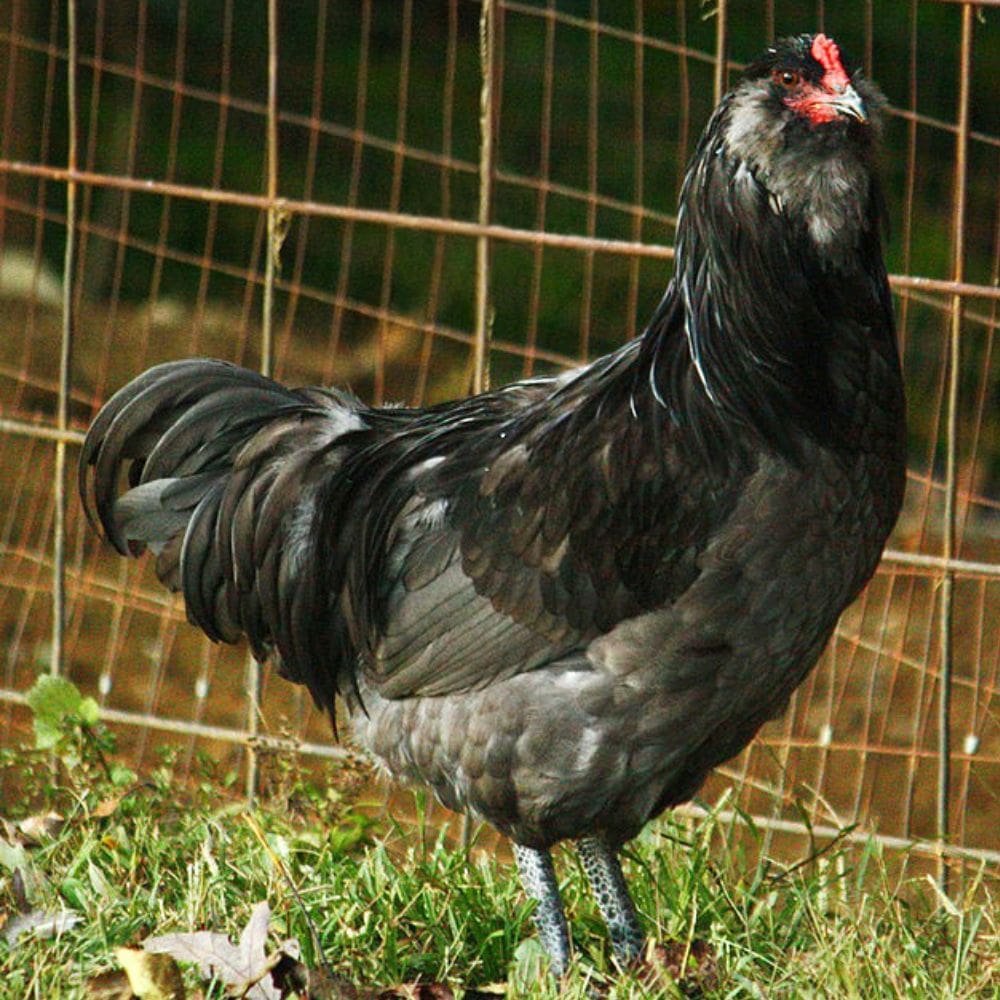
Araucana
- Rumpless (no tail feathers)
- Has ear tufts
- No beard
- No muffs
- Breeds true
- Blue Eggs
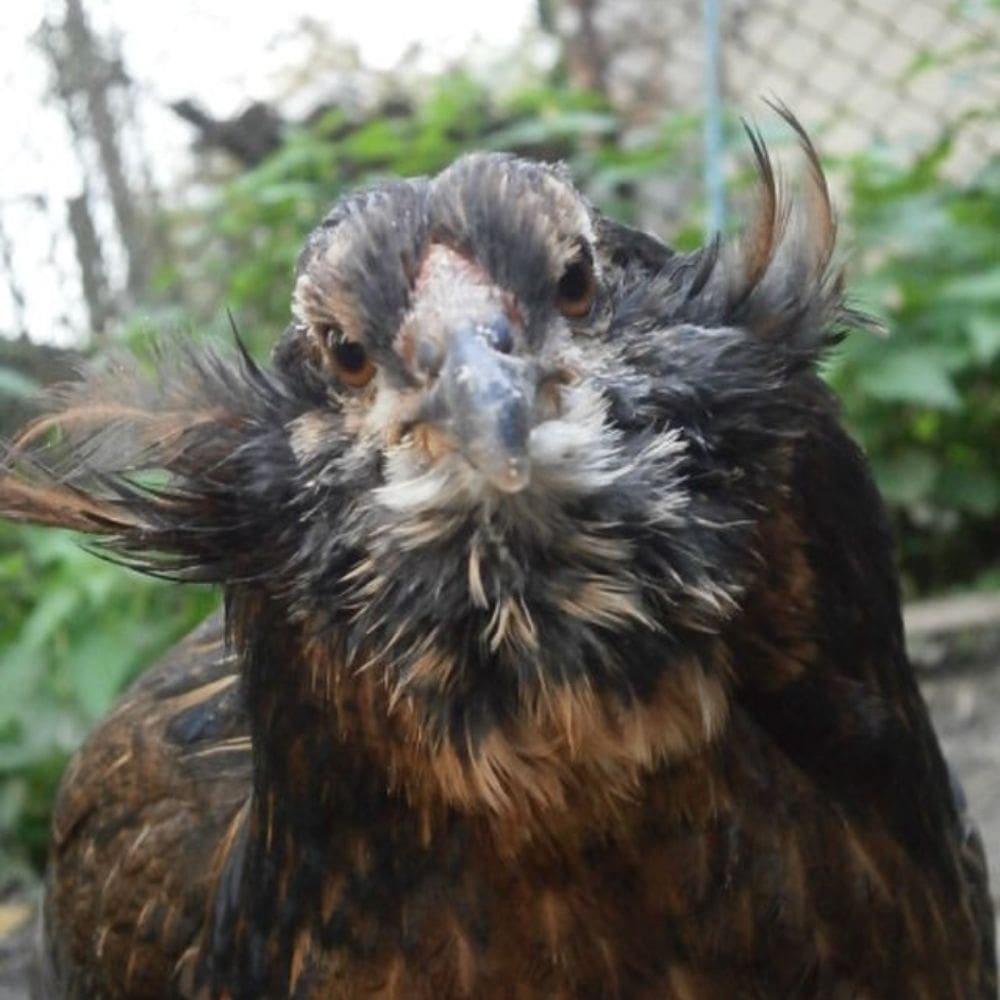
Easter Egger
- Hybrid that has mixed characteristics
- Many egg colors (but each hen will only lay one of those colors)
- Does not breed true
- Can have muffs and beards

Ameraucana Chicken Colors?
What colors do Ameraucana chickens come in? A lot! Be ready to have a colorful flock when you have these clucking in your coop or grazing in your backyard. Each variety come in different sets of color.
- black
- blue
- brown red
- buff silver
- blue wheaten
- wheaten
- white
Interesting Color Facts
- The blacks (and blues) are the most common Ameraucana colors. Some breeders are also working on new varieties like black gold and also lavender! How wonderful would those be?
- The black Ameraucana chicken is purely black with shiny coal black feathers aside from the red wattles, ears, and comb. The same is true for the white Ameraucana chicken – except it’s snow white and not black.
- Don’t expect sky-blue chickens to grow from a Blue Ameraucana chicken. The blues of this breed are more of an ashy blue or gray. This color is derived from the black Ameraucana chicken that has been diluted with the blue gene.
- The Ameraucana recognized variety, buff, is also quite interesting to look at, with its contrasting golden buff color and blue legs.
- Wheaten or blue wheaten color? It’s quite simple: blue feathers on blue wheatens will replace the black feathers on regular wheatens for both hens and roosters.
- Expect in general that males would have more orange tint with blue and gray shanks.
Just be aware that when you raise Ameraucana chicks, you’ll only be able to distinguish what color they will be as adults when they start feathering out. This is especially true if you get them from a hatchery, rather than a local dealer where you can see the parent stock.
Until then, you can only fantasize and stare at an ameraucana chicken color chart hoping they would turn out to be the colors you want to have. No matter what color your chicks turn out to be they’re guaranteed to have blue eggs in different shades as long as they are genuine/pure breeds.
How Big Do Ameraucana Chickens Get?
A standard Ameraucana chicken can weigh up to 4.5 – 6.5 lbs and stand up to 18” tall. Ameraucana bantam chickens are the cuter versions that grow half the size of a standard – and bantam chickens in general tend to be more cuddly with their humans than regular-sized chickens.
Ameraucana Chickens Egg Production
Are Ameraucanas Good Egg Layers?
There is no questioning the capabilities of the Ameraucana for egg production. They are one of the most productive egg laying breeds known to give at least 250 to 300 eggs a year, weighing approximately 53 – 60 grams.
Those are some nice, big, blue eggs!
Do Ameraucana Chickens Lay Eggs Everyday?
On the average, they produce 3-6 eggs a week, more in their first laying year. The exact amount they’ll lay – and whether they lay consistently – will depend on their diet and environment. It’s always best to provide a high-quality layer feed with at least 16% protein and plenty of calcium.
Note that chickens who do not have a good diet, or who free range for most of their nutrients, or have experienced some sort of stress, might not lay as well. You can explore reasons chickens stop laying eggs here.
What Age Do Ameraucana Chickens Lay Eggs?
They start laying eggs at about 6-7 months old, although it can depend on certain factors, such as the individual chicken, her diet, the time of year, etc.
Pullets that reach the 7 month mark during the darkest days of winter might not lay until spring, since 12-14 hours of light is needed to spur egg production. Once your hens do start laying, offer them a high quality layer feed with plenty of calcium.
Some breeders would say that it’s quite a long time before they start laying, but pretty colored eggs are worth the wait. When your hens start producing eggs, make sure they don’t go through too much stress like change in environment or feeding. Stressed hens might just stop laying.
Are Ameraucana Chicken Eggs Good to Eat?
Their eggs aren’t only coveted for their unique and gorgeous blue color. Ameraucana chicken eggs are one of the healthiest, with low cholesterol and rich flavors. And they taste just like any other white egg.
Are Ameraucana Chickens For You?
This breed is honestly hard to resist, especially if you like the various looks and colors they come in AND you want blue eggs. If you have read this far, then it’s a sign! Go get yourself some of these spunky, fun fluffy butts. What are you waiting for?
Maat van Uitert is a backyard chicken and sustainable living expert. She is also the author of Chickens: Naturally Raising A Sustainable Flock, which was a best seller in it’s Amazon category. Maat has been featured on NBC, CBS, AOL Finance, Community Chickens, the Huffington Post, Chickens magazine, Backyard Poultry, and Countryside Magazine. She lives on her farm in Southeast Missouri with her husband, two children, and about a million chickens and ducks. You can follow Maat on Facebook here and Instagram here.

